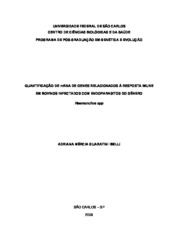| dc.contributor.author | Ibelli, Adriana Mércia Guaratini | |
| dc.date.accessioned | 2016-06-02T20:21:20Z | |
| dc.date.available | 2008-05-30 | |
| dc.date.available | 2016-06-02T20:21:20Z | |
| dc.date.issued | 2008-03-14 | |
| dc.identifier.citation | IBELLI, Adriana Mércia Guaratini. Quantificação de mRNA de genes relacionados à
resposta imune em bovinos infectados com endoparasitos
do gênero Haemonchus spp. 2008. 113 f. Dissertação (Mestrado em Ciências Biológicas) - Universidade Federal de São Carlos, São Carlos, 2008. | por |
| dc.identifier.uri | https://repositorio.ufscar.br/handle/ufscar/5446 | |
| dc.description.abstract | Brazilian livestock production presents great impact for the national agriculture,
possessing the largest bovine commercial herd of the world. However, the
productivity is low and gastrintestinal diseases caused by Haemonchus spp are one
of the major constraints to the production. It is known that those parasites are
responsible for many immunological responses in the host. Cytokine polarization
Th1/Th2 has been studied to understand the infections caused by nematodes.
However, the studies that try to understand immune response of cattle with
Haemonchus spp are still scarce. The goal of this work was to verify differences in
the mRNA abundance of genes involved in immune response of calves of Nelore
breed (Bos indicus) submitted to the first infection with Haemonchus spp, relating
these differences to patterns of cellular infiltrate. Genes were evaluated by real time
PCR and relative quantification was made by the software Relative Expression
Software Tool. Results showed up-regulation of the interleukins IL-4 (p≤0.05) and IL-
13 (p≤0.05) in the lymph node of challenged animals. No significant differences (p >
0.05) were found in mRNA abundance for the genes analyzed in abomasum. There
were no significant differences for mast cells and eosinophil counts in abomasal
tissue among analyzed groups. From the results, it can be concluded that for the
short infection time, there was increased polarization of Th2 in lymph node, but it was not seen in abomasal tissue. | eng |
| dc.description.sponsorship | Financiadora de Estudos e Projetos | |
| dc.format | application/pdf | por |
| dc.language | por | por |
| dc.publisher | Universidade Federal de São Carlos | por |
| dc.rights | Acesso Aberto | por |
| dc.subject | Bovino - genética | por |
| dc.subject | Imunogenética | por |
| dc.subject | Expressão
gênica | por |
| dc.subject | Nelore | por |
| dc.subject | Haemonchus spp | por |
| dc.title | Quantificação de mRNA de genes relacionados à
resposta imune em bovinos infectados com endoparasitos
do gênero Haemonchus spp | por |
| dc.type | Dissertação | por |
| dc.contributor.advisor1 | Regitano, Luciana Correia de Almeida | |
| dc.contributor.advisor1Lattes | http://genos.cnpq.br:12010/dwlattes/owa/prc_imp_cv_int?f_cod=K4782092Z0 | por |
| dc.description.resumo | RESUMO
A pecuária brasileira apresenta grande impacto para o setor agrícola nacional,
possuindo o maior rebanho bovino comercial do mundo. Em contrapartida, a
produtividade é baixa e as doenças causadas por endoparasitoses do gênero
Haemonchus são um dos principais limitantes na produção. Sabe-se que esses
parasitos são responsáveis por uma série de respostas imunológicas no hospedeiro.
A polarização de citocinas Th1/Th2 tem sido amplamente estudada visando
entender melhor as infecções causadas por parasitos gastrintestinais. Entretanto,
ainda são escassos os estudos que procuram entender a resposta imunológica de
bovinos endoparasitados com Haemonchus spp. Os objetivos deste trabalho foram
verificar diferenças na abundância de RNA mensageiro de genes relacionados à
resposta imune de bezerros da raça Nelore (Bos indicus) submetidos à primeira
infecção com Haemonchus spp, relacionando-as às respostas locais de infiltrados
celulares. Os genes foram quantificados por PCR em tempo real e a quantificação
relativa foi feita pelo programa computacional Relative Expression Software Tool. Os
resultados mostraram um aumento significativo das interleucinas IL-4 (p≤0,05) e IL-
13 (p≤0,05) nos linfonodos do grupo de animais desafiados. Não foram encontradas
diferenças significativas (p > 0,05) de abundância de mRNA para os genes
analisados no tecido abomasal. Não houve diferenças significativas (p > 0,05) para
contagens de mastócitos e eosinófilos no tecido abomasal entre os grupos
analisados. Assim, pode-se concluir que, para o curto período de infecção, houve
um aumento da polarização Th2 em linfonodo, mas não em abomaso. | por |
| dc.publisher.country | BR | por |
| dc.publisher.initials | UFSCar | por |
| dc.publisher.program | Programa de Pós-Graduação em Genética Evolutiva e Biologia Molecular - PPGGEv | por |
| dc.subject.cnpq | CIENCIAS BIOLOGICAS::GENETICA::GENETICA ANIMAL | por |
| dc.contributor.authorlattes | http://lattes.cnpq.br/4729789236742545 | por |
